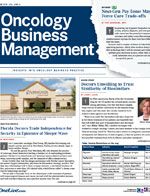Publication
Article
Special Issues
CMS Standards for Reporting Call for Advanced Technology, Training
Author(s):
Many oncology practices have already made progress in adding appropriate personnel and implementing technology solutions, such as EHR, to enhance their ability to document and report care plans and patient event data. However, to be successful in meeting the specific criteria set forth in the OCM, most existing EHRs will need to be enhanced.
Marcus Neubauer, MD
On June 30, the deadline passed for practices interested in participating in the Oncology Care Model (OCM) to submit their completed applications. Perhaps your practice was one of the more than 400 that submitted a letter of intent to participate and you are hoping to be among the 100 or so selected for the program.
The OCM is a program developed by the Center for Medicare & Medicaid Innovation (CMMI) that seeks to improve the effectiveness and efficiency of specialty healthcare through a new payment and delivery model. It requires participating physician practices that administer chemotherapy to enter into payment agreements with CMS to measure and perform on quality metrics during an episode of care. In exchange, CMS pays practices an incentive for Medicare fee-for-service beneficiaries of $160 per beneficiary per month for the duration of the episode. The program also includes potential performance-based payments that are specifically designed to encourage coordinated quality care at a lower cost during the episode.
The goal of this program is to appropriately align financial incentives to improve care coordination, appropriateness of care, and access to care for beneficiaries undergoing chemotherapy. Ultimately, these improvements are intended to result in better care, smarter spending, and healthier people. Similar programs have been under way in general practice for quite some time, and CMMI is now expanding to specialty care. So, why oncology? Oncology is an obvious first choice. The cost of treating cancer—especially chemotherapy—is highly variable, but mostly expensive. Furthermore, more than 1.6 million people are diagnosed with cancer each year, with a majority of those being over 65. Factor in the US Census Bureau’s prediction that by 2030 more than 20% of the American population is expected to be over 65, and it’s easy to see why oncology is on the radar.
CMS is not the only group to be heading down the road toward alternative payment models. At the 2015 ASCO Annual Meeting, the society announced a similar program called Patient-Centered Oncology Payment (PCOP). Their proposal is designed to simultaneously improve services to patients and reduce spending for Medicare and other payers. Likewise, many if not all private payers have similar initiatives under way. In fact, CMS is encouraging other payers to join their efforts to create a multi-payer model that would streamline transformation at the physician practices.
Practices chosen to participate in the OCM will have their work cut out for them. The program is slated to officially kick off in spring 2016, meaning that practices will need to begin to “transform” quickly to ensure they will be able to meet the performance and reporting criteria required of the program.
The addition to the practice of patient navigators who proactively monitor and perform outreach to patients is a requirement of OCM participation. It’s also clear that technology will play a vital role in enabling practices to successfully participate in this program.
Many oncology practices have already made progress in adding appropriate personnel and implementing technology solutions, such as Electronic Health Records (EHR), to enhance their ability to document and report care plans and patient event data. However, to be successful in meeting the specific criteria set forth in the OCM, most existing EHRs will need to be enhanced.
Practices must closely collaborate with their EHR vendors to clearly outline the requirements of multiple programs including Meaningful Use, PQRS, the OCM and other reimbursement models as introduced by private payers. It is important that practices are capable of participating and performing in more than 1 alternative payment model. This may require significant EHR enhancements.
Technology, necessary for successful participation in the OCM, will go beyond EHRs. For example, practices will receive claims data from payers that will be rich in information but will require analysis and interpretation. Solutions offered by McKesson Specialty Health consolidate data from internal and external sources and support practices through the entire care lifecycle, from treatment selection and administration to patient-reported outcomes, billed charges, and payer Explanations of Benefits (EOBs). These clinical, operational, and financial insights into the coordination, cost, and value of patient care can help practices in making timely and appropriate decisions, while providing comprehensive data for OCM reporting.
As many practices anxiously await the decision from CMS as to whether they have been selected for the OCM, it is clear that the way oncology practices will be reimbursed is changing. So, regardless of whether your practice is chosen for the OCM, it’s time to accept (and even embrace) change and begin taking steps toward transforming your practice.
Marcus Neubauer is medical director of oncology services at McKesson Specialty Health.





















%20(2)%201-Recovered-Recovered-Recovered-Recovered-Recovered-Recovered-Recovered-Recovered-Recovered-Recovered-Recovered-Recovered-Recovered-Recovered-Recovered-Recovered-Recovered.jpg?fit=crop&auto=format)
%20(2)%201-Recovered-Recovered-Recovered-Recovered-Recovered-Recovered-Recovered-Recovered-Recovered-Recovered-Recovered-Recovered-Recovered-Recovered-Recovered-Recovered-Recovered.jpg?fit=crop&auto=format)